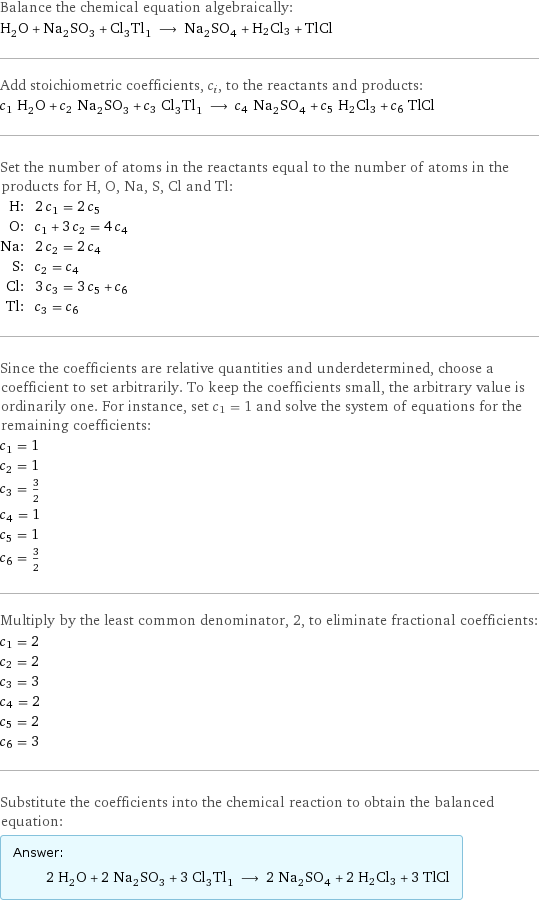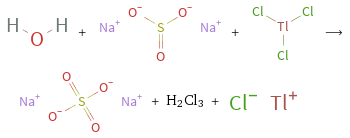Input interpretation

H_2O water + Na_2SO_3 sodium sulfite + Cl_3Tl_1 thallium(III) chloride ⟶ Na_2SO_4 sodium sulfate + H2Cl3 + TlCl thallium chloride
Balanced equation

Balance the chemical equation algebraically: H_2O + Na_2SO_3 + Cl_3Tl_1 ⟶ Na_2SO_4 + H2Cl3 + TlCl Add stoichiometric coefficients, c_i, to the reactants and products: c_1 H_2O + c_2 Na_2SO_3 + c_3 Cl_3Tl_1 ⟶ c_4 Na_2SO_4 + c_5 H2Cl3 + c_6 TlCl Set the number of atoms in the reactants equal to the number of atoms in the products for H, O, Na, S, Cl and Tl: H: | 2 c_1 = 2 c_5 O: | c_1 + 3 c_2 = 4 c_4 Na: | 2 c_2 = 2 c_4 S: | c_2 = c_4 Cl: | 3 c_3 = 3 c_5 + c_6 Tl: | c_3 = c_6 Since the coefficients are relative quantities and underdetermined, choose a coefficient to set arbitrarily. To keep the coefficients small, the arbitrary value is ordinarily one. For instance, set c_1 = 1 and solve the system of equations for the remaining coefficients: c_1 = 1 c_2 = 1 c_3 = 3/2 c_4 = 1 c_5 = 1 c_6 = 3/2 Multiply by the least common denominator, 2, to eliminate fractional coefficients: c_1 = 2 c_2 = 2 c_3 = 3 c_4 = 2 c_5 = 2 c_6 = 3 Substitute the coefficients into the chemical reaction to obtain the balanced equation: Answer: | | 2 H_2O + 2 Na_2SO_3 + 3 Cl_3Tl_1 ⟶ 2 Na_2SO_4 + 2 H2Cl3 + 3 TlCl
Structures

+ + ⟶ + H2Cl3 +
Names

water + sodium sulfite + thallium(III) chloride ⟶ sodium sulfate + H2Cl3 + thallium chloride
Equilibrium constant
![Construct the equilibrium constant, K, expression for: H_2O + Na_2SO_3 + Cl_3Tl_1 ⟶ Na_2SO_4 + H2Cl3 + TlCl Plan: • Balance the chemical equation. • Determine the stoichiometric numbers. • Assemble the activity expression for each chemical species. • Use the activity expressions to build the equilibrium constant expression. Write the balanced chemical equation: 2 H_2O + 2 Na_2SO_3 + 3 Cl_3Tl_1 ⟶ 2 Na_2SO_4 + 2 H2Cl3 + 3 TlCl Assign stoichiometric numbers, ν_i, using the stoichiometric coefficients, c_i, from the balanced chemical equation in the following manner: ν_i = -c_i for reactants and ν_i = c_i for products: chemical species | c_i | ν_i H_2O | 2 | -2 Na_2SO_3 | 2 | -2 Cl_3Tl_1 | 3 | -3 Na_2SO_4 | 2 | 2 H2Cl3 | 2 | 2 TlCl | 3 | 3 Assemble the activity expressions accounting for the state of matter and ν_i: chemical species | c_i | ν_i | activity expression H_2O | 2 | -2 | ([H2O])^(-2) Na_2SO_3 | 2 | -2 | ([Na2SO3])^(-2) Cl_3Tl_1 | 3 | -3 | ([Cl3Tl1])^(-3) Na_2SO_4 | 2 | 2 | ([Na2SO4])^2 H2Cl3 | 2 | 2 | ([H2Cl3])^2 TlCl | 3 | 3 | ([TlCl])^3 The equilibrium constant symbol in the concentration basis is: K_c Mulitply the activity expressions to arrive at the K_c expression: Answer: | | K_c = ([H2O])^(-2) ([Na2SO3])^(-2) ([Cl3Tl1])^(-3) ([Na2SO4])^2 ([H2Cl3])^2 ([TlCl])^3 = (([Na2SO4])^2 ([H2Cl3])^2 ([TlCl])^3)/(([H2O])^2 ([Na2SO3])^2 ([Cl3Tl1])^3)](../image_source/4b36a242ebc0b8b6dbfd03481349d9b4.png)
Construct the equilibrium constant, K, expression for: H_2O + Na_2SO_3 + Cl_3Tl_1 ⟶ Na_2SO_4 + H2Cl3 + TlCl Plan: • Balance the chemical equation. • Determine the stoichiometric numbers. • Assemble the activity expression for each chemical species. • Use the activity expressions to build the equilibrium constant expression. Write the balanced chemical equation: 2 H_2O + 2 Na_2SO_3 + 3 Cl_3Tl_1 ⟶ 2 Na_2SO_4 + 2 H2Cl3 + 3 TlCl Assign stoichiometric numbers, ν_i, using the stoichiometric coefficients, c_i, from the balanced chemical equation in the following manner: ν_i = -c_i for reactants and ν_i = c_i for products: chemical species | c_i | ν_i H_2O | 2 | -2 Na_2SO_3 | 2 | -2 Cl_3Tl_1 | 3 | -3 Na_2SO_4 | 2 | 2 H2Cl3 | 2 | 2 TlCl | 3 | 3 Assemble the activity expressions accounting for the state of matter and ν_i: chemical species | c_i | ν_i | activity expression H_2O | 2 | -2 | ([H2O])^(-2) Na_2SO_3 | 2 | -2 | ([Na2SO3])^(-2) Cl_3Tl_1 | 3 | -3 | ([Cl3Tl1])^(-3) Na_2SO_4 | 2 | 2 | ([Na2SO4])^2 H2Cl3 | 2 | 2 | ([H2Cl3])^2 TlCl | 3 | 3 | ([TlCl])^3 The equilibrium constant symbol in the concentration basis is: K_c Mulitply the activity expressions to arrive at the K_c expression: Answer: | | K_c = ([H2O])^(-2) ([Na2SO3])^(-2) ([Cl3Tl1])^(-3) ([Na2SO4])^2 ([H2Cl3])^2 ([TlCl])^3 = (([Na2SO4])^2 ([H2Cl3])^2 ([TlCl])^3)/(([H2O])^2 ([Na2SO3])^2 ([Cl3Tl1])^3)
Rate of reaction
![Construct the rate of reaction expression for: H_2O + Na_2SO_3 + Cl_3Tl_1 ⟶ Na_2SO_4 + H2Cl3 + TlCl Plan: • Balance the chemical equation. • Determine the stoichiometric numbers. • Assemble the rate term for each chemical species. • Write the rate of reaction expression. Write the balanced chemical equation: 2 H_2O + 2 Na_2SO_3 + 3 Cl_3Tl_1 ⟶ 2 Na_2SO_4 + 2 H2Cl3 + 3 TlCl Assign stoichiometric numbers, ν_i, using the stoichiometric coefficients, c_i, from the balanced chemical equation in the following manner: ν_i = -c_i for reactants and ν_i = c_i for products: chemical species | c_i | ν_i H_2O | 2 | -2 Na_2SO_3 | 2 | -2 Cl_3Tl_1 | 3 | -3 Na_2SO_4 | 2 | 2 H2Cl3 | 2 | 2 TlCl | 3 | 3 The rate term for each chemical species, B_i, is 1/ν_i(Δ[B_i])/(Δt) where [B_i] is the amount concentration and t is time: chemical species | c_i | ν_i | rate term H_2O | 2 | -2 | -1/2 (Δ[H2O])/(Δt) Na_2SO_3 | 2 | -2 | -1/2 (Δ[Na2SO3])/(Δt) Cl_3Tl_1 | 3 | -3 | -1/3 (Δ[Cl3Tl1])/(Δt) Na_2SO_4 | 2 | 2 | 1/2 (Δ[Na2SO4])/(Δt) H2Cl3 | 2 | 2 | 1/2 (Δ[H2Cl3])/(Δt) TlCl | 3 | 3 | 1/3 (Δ[TlCl])/(Δt) (for infinitesimal rate of change, replace Δ with d) Set the rate terms equal to each other to arrive at the rate expression: Answer: | | rate = -1/2 (Δ[H2O])/(Δt) = -1/2 (Δ[Na2SO3])/(Δt) = -1/3 (Δ[Cl3Tl1])/(Δt) = 1/2 (Δ[Na2SO4])/(Δt) = 1/2 (Δ[H2Cl3])/(Δt) = 1/3 (Δ[TlCl])/(Δt) (assuming constant volume and no accumulation of intermediates or side products)](../image_source/f4c8d6c2954bd698be018ca09430e16a.png)
Construct the rate of reaction expression for: H_2O + Na_2SO_3 + Cl_3Tl_1 ⟶ Na_2SO_4 + H2Cl3 + TlCl Plan: • Balance the chemical equation. • Determine the stoichiometric numbers. • Assemble the rate term for each chemical species. • Write the rate of reaction expression. Write the balanced chemical equation: 2 H_2O + 2 Na_2SO_3 + 3 Cl_3Tl_1 ⟶ 2 Na_2SO_4 + 2 H2Cl3 + 3 TlCl Assign stoichiometric numbers, ν_i, using the stoichiometric coefficients, c_i, from the balanced chemical equation in the following manner: ν_i = -c_i for reactants and ν_i = c_i for products: chemical species | c_i | ν_i H_2O | 2 | -2 Na_2SO_3 | 2 | -2 Cl_3Tl_1 | 3 | -3 Na_2SO_4 | 2 | 2 H2Cl3 | 2 | 2 TlCl | 3 | 3 The rate term for each chemical species, B_i, is 1/ν_i(Δ[B_i])/(Δt) where [B_i] is the amount concentration and t is time: chemical species | c_i | ν_i | rate term H_2O | 2 | -2 | -1/2 (Δ[H2O])/(Δt) Na_2SO_3 | 2 | -2 | -1/2 (Δ[Na2SO3])/(Δt) Cl_3Tl_1 | 3 | -3 | -1/3 (Δ[Cl3Tl1])/(Δt) Na_2SO_4 | 2 | 2 | 1/2 (Δ[Na2SO4])/(Δt) H2Cl3 | 2 | 2 | 1/2 (Δ[H2Cl3])/(Δt) TlCl | 3 | 3 | 1/3 (Δ[TlCl])/(Δt) (for infinitesimal rate of change, replace Δ with d) Set the rate terms equal to each other to arrive at the rate expression: Answer: | | rate = -1/2 (Δ[H2O])/(Δt) = -1/2 (Δ[Na2SO3])/(Δt) = -1/3 (Δ[Cl3Tl1])/(Δt) = 1/2 (Δ[Na2SO4])/(Δt) = 1/2 (Δ[H2Cl3])/(Δt) = 1/3 (Δ[TlCl])/(Δt) (assuming constant volume and no accumulation of intermediates or side products)
Chemical names and formulas

| water | sodium sulfite | thallium(III) chloride | sodium sulfate | H2Cl3 | thallium chloride formula | H_2O | Na_2SO_3 | Cl_3Tl_1 | Na_2SO_4 | H2Cl3 | TlCl Hill formula | H_2O | Na_2O_3S | Cl_3Tl | Na_2O_4S | H2Cl3 | ClTl name | water | sodium sulfite | thallium(III) chloride | sodium sulfate | | thallium chloride IUPAC name | water | disodium sulfite | trichlorothallane | disodium sulfate | |
Substance properties

| water | sodium sulfite | thallium(III) chloride | sodium sulfate | H2Cl3 | thallium chloride molar mass | 18.015 g/mol | 126.04 g/mol | 310.7 g/mol | 142.04 g/mol | 108.4 g/mol | 239.83 g/mol phase | liquid (at STP) | solid (at STP) | | solid (at STP) | | solid (at STP) melting point | 0 °C | 500 °C | | 884 °C | | 430 °C boiling point | 99.9839 °C | | | 1429 °C | | 720 °C density | 1 g/cm^3 | 2.63 g/cm^3 | | 2.68 g/cm^3 | | 7 g/cm^3 solubility in water | | | | soluble | | slightly soluble surface tension | 0.0728 N/m | | | | | dynamic viscosity | 8.9×10^-4 Pa s (at 25 °C) | | | | | odor | odorless | | | | |
Units
